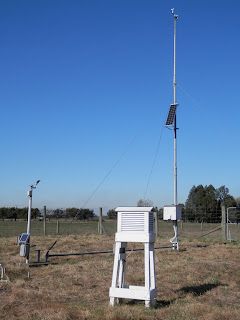Are there warm spots in Rangiora?
In air quality lingo we normally refer to small areas of increased pollutant concentrations as hot spots but since this story is about the temperature field I needed to use something else ... warm spots will do. As part of the measurement campaign we deployed in Rangiora we not only used ODINs but also four weather stations (like the one on the picture) scattered around the town to explore small scale wind flows and how uniform or otherwise the temperature field is in the area. Before we dive too deep in the analysis, let's pause and look at the two kind of temperature sensors used here. First is the meteorological sites that have thoroughly calibrated and well housed thermometers, protected from the sunshine while the ODIN thermometers were ... well ... not perfectly housed (see image of the inside of an ODIN) and then put in plain sunlight attached to lamp posts (see image of ODIN attached to a lamp post). Now, don't despair! There is a reason why the ODIN tem...



